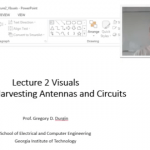 In this lecture of the Wireless Without Batteries series, we discuss the basics of modeling antennas in circuits –both in transmit mode and receive mode. Below is a reading list corresponding to the material.
In this lecture of the Wireless Without Batteries series, we discuss the basics of modeling antennas in circuits –both in transmit mode and receive mode. Below is a reading list corresponding to the material.
WWB02: Antennas in Circuits for Energy Harvesting
Paper: C.R. Valenta, G.D. Durgin. “Survey of Energy-harvester Conversion Efficiency in Far-field, Wireless Power Transfer Systems.” IEEE Microwave Magazine. vol 14, no 4, June 2014. 10 pages.
Reading: WWB Notes on Antennas in Circuits


